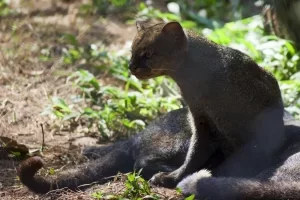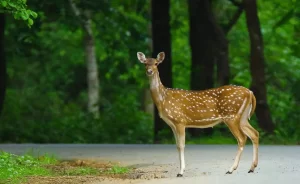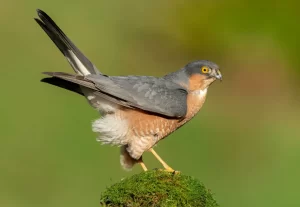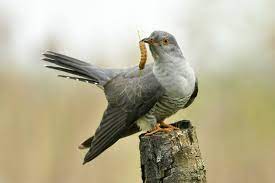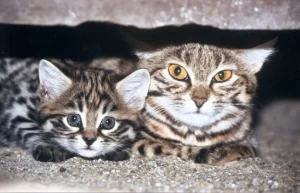The jaguarundi is amongst the most unusual of cat species in the New World, being rather weasel-like in its looks. Its body is slender and long, with a small flattened head, short legs, a long tail, and short rounded ears. The species has two main color morphs: one being dark, i.e. uniform black, gray, or brownish, sometimes a little lighter on the undersides, and a red morph, which can vary from tawny yellow to a bright chestnut red.

Due to looking like a weasel, the dark morph jaguarundi will often be mistaken for the tayra, which is a large mustelid, but it lacks the tayra’s yellowish spot on the throat and has a very long, thin tail and very short hair.
Read Pritish Kumar Halder’s full article and get complete knowledge of Jaguarundi.
Distribution
The jaguarondi is widely distributed throughout North, Central, and South America, ranging from southern Texas to as far south as northern Argentina.

Jaguarundi – distribution
It occurs in a wide range of open as well as closed habitats, such as rainforest, thickets, savanna, swamp, and savanna woodland, as well as semi-arid thorn scrub. It may also live in secondary vegetation and areas that have been disturbed but is believed to prefer areas that have at least some thick ground cover.
Habits and Lifestyle
Jaguarundis are very secretive animals. They are solitary apart from during the mating season. These animals are mostly diurnal, with most of their activity taking place at about 11 in the morning. Jaguarundis are terrestrial creatures; they are efficient climbers as well but hunt mainly on the ground. They are also very good swimmers.
They are quite vocal, with at least 13 different calls having been recorded, including a purr, scream, whistle, chatter, yap, and a “chirp” like a bird. Mothers will often call to their kittens with a brief purr, the kittens answering with a series of short peeps. In warning, a jaguarundi will hiss loudly and/or spit.
Diet and Nutrition
Jaguarundis are carnivorous and eat small mammals such as reptiles, birds, fish, and frogs.

Jaguarundi – eating habit
Mating Habits
Jaguarundis are polygynous, which means that one male gets exclusive mating rights with multiple females. Breeding may take place at any time of the year. In Mexico, the mating season is during November and December. The animals construct dens, typically in dense thickets or hollow logs. Litters are between 1 to 4 kittens, born after a gestation time from 63 to 75 days.
Kittens are born blind and helpless and are weaned when about 2 months old; then their mother teaches them how to hunt and look after themselves. She protects them and will move her den when disturbed. Independence comes at around 10 months of age and sexual maturity is reached at about 2 – 3 years old.
Population
Population threats
The numbers of jaguarundis are decreasing every day, due to the loss of their natural habitat, deforestation, and expanding cities. Jaguarundis are hunted by farmers because they eat their poultry, and they are sometimes caught accidentally in traps laid for other animals.

Population number
According to the IUCN Red List, research indicates that the Jaguarundi is an uncommon, low-density species. It is considered Near Threatened in Argentina and Threatened in Mexico. But globally, it is classified as Least Concern (LC) with decreasing population trend.They can leap up to 2 m (6 ft 7 in) into the air to catch birds.
Threats and conservation
The jaguarundi has been listed as Least Concern on the IUCN Red List since 2002. Mexican populations, except those in the northeast, appear to be stable. The huge protected areas in the Amazon Basin are probably the only conservation units that can sustain long-term viable populations. IUCN Red List assessors noted that it should be listed as Near Threatened, but the data were not sufficient to extend this classification throughout the jaguarundi’s range. The jaguarundi is not particularly sought after for its fur due to its poor quality and low value, but it is suffering decline due to habitat loss.

Jaguarundi – in forest
Other threats include risks of habitat fragmentation and persecution for killing poultry. The North and Central American jaguarundi populations are listed in CITES Appendix I and all the other populations are listed in CITES Appendix II. Populations in the US are protected under the Endangered Species Act; the Texas Parks and Wildlife Department has expressed concern that its presence in South Texas may be imperiled due to loss of the cat’s native habitat.
Fun Facts for Kids
- Jaguarundis are excellent swimmers and can cross lakes and narrow, weak current rivers.
- Jaguarundis are shy and are cautious traps set by humans.
- Jaguarondis spend the majority of their time on the ground, unlike many other South American cats, and climb up into trees to rest.
- Jaguarundi can jump as high as 6.5 feet to catch a bird in flight.
- Jaguarundi kittens have spotted fur when they are born. The spots will have gone when they are 3 months old.
- The jaguarundi is called the “halari” in Belize.
- Jaguarundis are thought to be descended from the puma, which originally came from Asia.
Reference
https://animalia.bio/jaguarundi?environment=331

